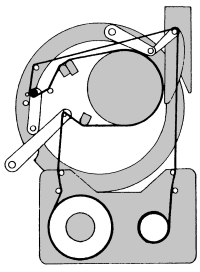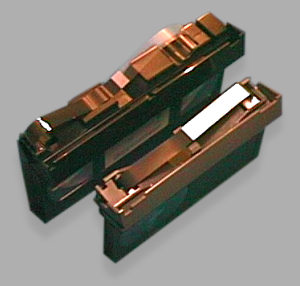Betamax the Better Format
|
|
 Betamax U-Loading
The tape path is as follows, the tape leaves the supply ( left hand ) spool via internal guide posts and travels around the tension regulator. In most models the back tension is regulated by mechanical feedback but in a few advanced models notably the SL-C9 a sophisticated electronic system is used. After the tension arm the tape travels past a few more guides and enters the video drum assembly after passing the full tack erase head. The guides serve to 'bias' the tape ribbon onto the drum cylinder ruler edge. Tape travels around the drum on a 186 degree wrap and leaves the drum assembly to the audio and control track heads which incorporate ceramic plates to guide the tape. Next the tape passes between the capstan drive spindle and the pinch roller, which performs the tape drive. After this the tape passes through peripheral guides before re-entering the cassette shell. The take up spool is lightly driven to provide take up tension and ensure there is no slack. Unique to the Betamax format are two small springs which tension plastic tips to bias the tape as it travels around the drum. The video head tip contacts the video head at the bottom edge and leaves it at the upper edge. The video head rotates in the same direction as the tape moves. The tape is 1/2 inch thick and has the audio track at the top and the control track at the bottom edge. The original Betamax specification defined a single audio track 1.05mm wide. When the format was later revised to allow for a stereo sound track it was necessary to squeeze both tracks into the original space which gave disappointing results.  Metallic leader tape
There was no room for a guard band between video track because this would have resulted in too small a recording time for the given tape lengths. This meant that azimuth slant techniques were needed to minimise cross-talk between adjacent video tracks. The slant angle is +/- 7 degrees which meant that with a track angle of 5 degrees 58 seconds and a track width of 32 microns it was not possible to achieve a noise free picture in freeze frame mode unless a special effect head was employed. Tape end sensors in the Beta format operate on an inductive system, with each sensor being a coil forming part of an oscillator tuned circuit. Betamax leader tape consists of metallic material that, when they come into the proximity of the sensor, cause it to saturate and the oscillator to stop. |
||||||||||||||||||||||||||||||||||
Beta Hi-Fi Sound
|
Beta Hi-fi has a deviation of 500kHz compared to the other system's 150kHz.
Unlike the rival format, Betamax records an additional pilot colour burst onto tape which results in more accurate colour reproduction. |
To improve the sound quality of the format Sony developed
Beta Hi-fi. This recorded Hi-fi quality sound as FM audio tracks by
means of separate audio heads mounted on the video drum. The audio signals are modulated on to two carriers, one at 1.44MHz and the other at 2.10MHz. The deviation is 500KHz in contrast to 150kHz for the rival VHS format. The tracks are laid down so as to straddle the gaps in between the video tracks. The azimuth off-set is 30 degrees. |

